Your garden looks amazing by day but vanishes at night. This hides its beauty and can feel unsafe. LED floodlights can easily transform your space into a glowing masterpiece.
Use LED floodlights to highlight key features like trees, walls, or statues. This technique, called uplighting, creates dramatic shadows and adds depth. You can also use them for silhouetting or wall-washing to achieve a soft, beautiful glow and enhance your landscape’s nighttime appeal.
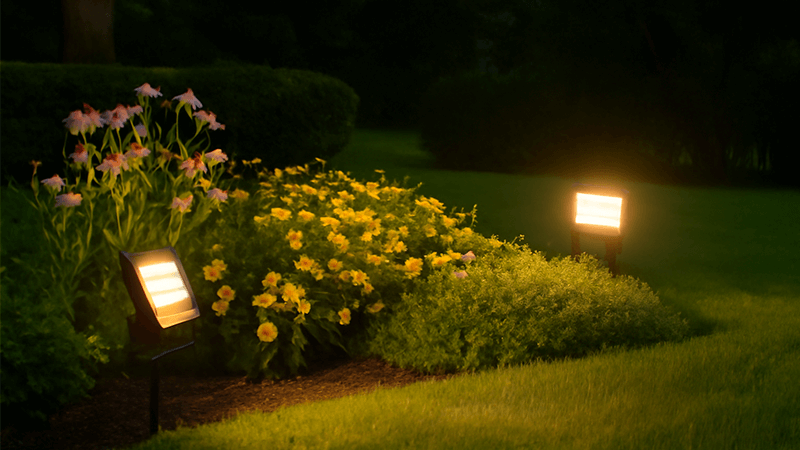
So, you see how simple it is to use floodlights for a great effect. But this is just the beginning. To get it right, you need to understand details like brightness, the type of light to use, and how to handle them correctly. Let’s look into these questions.
What is the best brightness for outdoor flood lights?
Afraid of making your garden look like an airport runway? Too much light is harsh, but too little is useless. Getting the right brightness is key for a perfect look.
For landscape accents like trees or shrubs, 400-800 lumens is ideal. For larger areas or security, 1000-3000 lumens works well. Always start lower and adjust. The goal is a gentle highlight, not overpowering brightness. Consider using dimmable fixtures for maximum control.
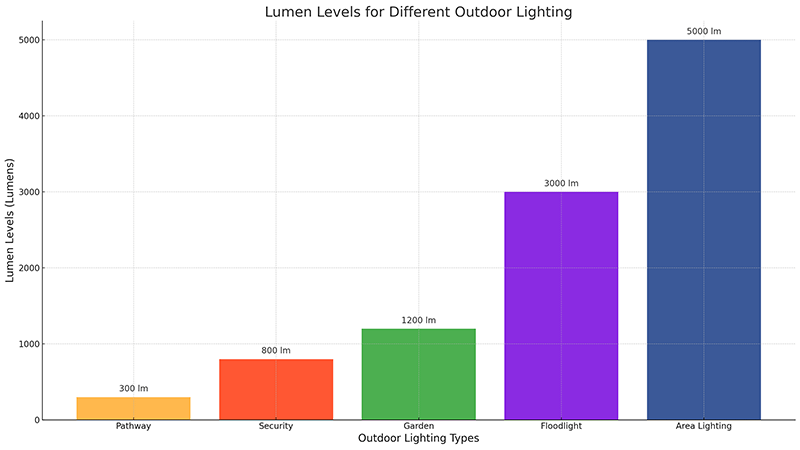
Choosing the right brightness goes beyond a single number. It is about creating a mood and highlighting beauty without being overwhelming. To do this, we need to look at lumens, color temperature, and beam angle together.
Understanding Lumens and Your Landscape
Lumens measure the total amount of visible light from a source. Think of it as the ‘quantity’ of light. For landscape lighting, more is not always better. A soft glow on a flower bed might only need 100-300 lumens. But lighting a 50-foot oak tree might require 1,200 lumens or more. As a purchasing manager, it’s vital to specify the right lumen package for each application. I remember a client in Dubai who wanted to light up a row of palm trees. He initially ordered very bright, cool white lights. We convinced him to try warmer, lower-lumen floodlights with a narrow beam. The difference was amazing—it created an elegant, resort-like feel instead of a stadium look.
Why Color Temperature Matters
Color temperature, measured in Kelvin (K), describes the color of the light. Lower Kelvin values (2700K-3000K) produce a warm, amber-like light that is very inviting. This is perfect for stone, wood, and most plants. Higher Kelvin values (4000K-5000K) produce a cool, bluish-white light. This looks more modern and is often used for security lighting, but it can make a garden feel sterile if not used carefully.
The Impact of Beam Angle
The beam angle determines how wide the light spreads. A narrow beam (a ‘spot’) is great for tall, thin objects like a column or a flagpole. A wide beam (a ‘flood’) is used to wash a wall with light or illuminate a wide shrub.
Here is a simple guide to help you choose:
| Application |
Recommended Lumens |
Color Temperature (Kelvin) |
| Small Shrubs & Plants |
100 – 300 |
2700K – 3000K |
| Medium Trees (up to 25 ft) |
400 – 800 |
2700K – 3000K |
| Large Trees & Façades |
800 – 1500 |
3000K – 4000K |
| Wall Washing & Security |
1200 – 3000+ |
4000K – 5000K |
What is the difference between landscape lights and flood lights?
It’s easy to get confused by lighting terms. Using the wrong fixture wastes money and creates a poor result. I’ll make the difference between them very clear for you.
Flood lights are a type of landscape light. They cast a wide beam to illuminate a large area. Other landscape lights, like spotlights, have narrow beams for specific features. Path lights are for walkways. Think of "landscape lights" as the category and "flood lights" as one tool.
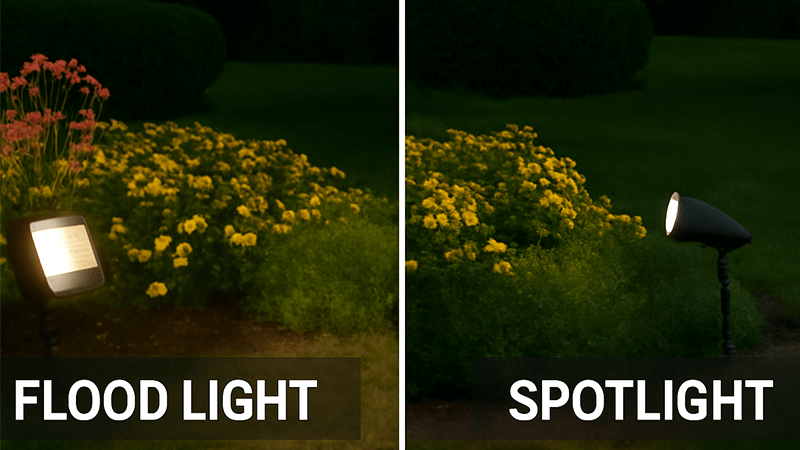
Understanding these differences is crucial for any project. You wouldn’t use a hammer to turn a screw. In the same way, you need the right lighting tool for the job. Let’s break down the main types you will encounter.
Floodlights: The Broad Brush
Floodlights are the workhorses for broad illumination. Their purpose is to "flood" an area with light. This makes them perfect for lighting up the side of a house, a large stone wall, or a cluster of large trees. They provide general brightness and can enhance security by eliminating dark spots. You select a floodlight when the goal is to see the whole scene, not just one part of it.
Spotlights: The Fine Pen
Spotlights are the opposite. They produce a concentrated, narrow beam of light. Their purpose is to draw attention to a specific feature. Think of a spotlight like a pointer, highlighting a garden statue, a beautiful fountain, or the texture of a tree’s bark. They create drama and contrast, making specific elements stand out from the background.
The Physical Design Makes the Difference
The physical design is what really separates a good light from a bad one. In my years running a factory, I’ve seen it firsthand. The way the tiny LED chips are arranged on the board, and the design of the lens or diffuser on top, determines everything. A poorly designed lens will create ugly color spots or an uneven beam. This is called poor light mixing. We focus on advanced optics to ensure our floodlights deliver a smooth, even glow without any distracting spots. This is a critical detail for professionals. For a purchasing manager, understanding this prevents costly mistakes and ensures the designer’s vision is realized.
| Feature |
Flood Light |
Spot Light |
Path Light |
| Beam Angle |
Wide (40-120 degrees) |
Narrow (10-40 degrees) |
Downward/360 degrees |
| Primary Use |
Illuminating large areas |
Highlighting specific objects |
Lighting walkways |
| Typical Lumens |
700 – 3000+ |
300 – 1200 |
100 – 200 |
| Placement |
Further from the object |
Closer to the object |
Along a path |
Can you use LED flood lights outside?
Placing an indoor light outside is a recipe for disaster. Rain and dust can ruin it in weeks, wasting your money. You need lights specifically designed for the outdoors.
Yes, you absolutely can, but only if they are rated for outdoor use. Look for an IP (Ingress Protection) rating of IP65 or higher. This ensures the fixture is protected against dust and water jets, making it safe and durable for any weather condition.
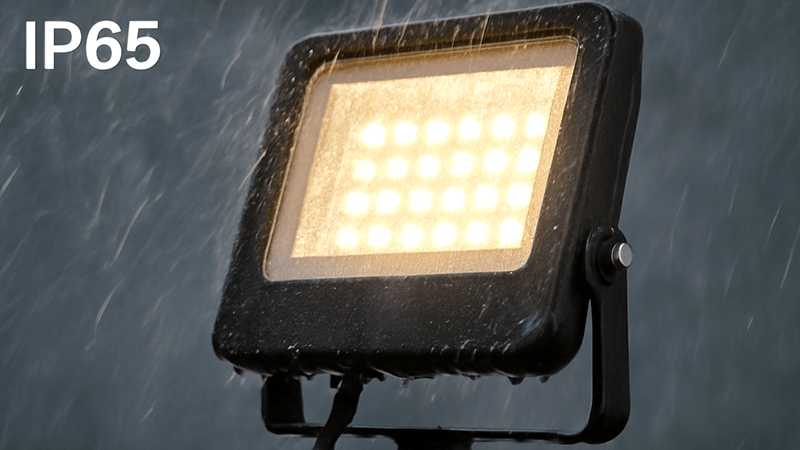
Using floodlights outside requires more than just picking a bright light. It has to withstand everything nature throws at it. From my manufacturing experience, three things are critical for outdoor durability: the IP rating, the materials used, and how well it manages heat.
Decoding IP Ratings
The IP rating is a two-digit code that tells you how well a fixture is sealed.
The first digit rates protection against solids, like dust. A ‘6’ is the highest rating, meaning it’s completely dust-tight.
The second digit rates protection against liquids, like water.
- IP65: This is the minimum I recommend for any quality outdoor floodlight. It is dust-tight and protected against water jets from any direction.
- IP66: Is protected against powerful water jets. This is better for areas hit by sprinklers or pressure washers.
- IP67: Can be temporarily submerged in water. This is for fixtures that might sit in puddles or are in areas prone to flooding.
Materials Matter in Harsh Climates
The body of the floodlight, or its housing, is very important. I always recommend die-cast aluminum because it is strong and excellent at dissipating heat. The finish is also key. A good polyester powder coating will resist corrosion, chipping, and fading from the sun. This is vital in a place like the UAE, where intense sun and heat can quickly degrade poor-quality finishes. I always advise my clients there to check the quality of the finish to ensure a long product life.
Keeping Cool: The Importance of Heat Sinks
Heat is the biggest enemy of an LED chip. If it gets too hot, its lifespan and light output will decrease dramatically. The fins you see on the back of a floodlight are a heat sink. They are not just for looks. They increase the surface area to pull heat away from the LEDs. In my factory, we run thermal tests to make sure our lights perform well even in hot environments up to 50°C, like those found in the Middle East. This ensures reliability for my clients.
What are the negative effects of LED lights?
While LEDs are great, you might worry about their downsides. Poor lighting can cause glare and light pollution. But you can easily avoid these problems with the right choices.
The main negative effects are glare, light pollution, and potential disruption to wildlife and human sleep cycles from blue-rich light. You can minimize these by choosing warmer color temperatures (under 3000K), using shielded fixtures that direct light downwards, and using only the necessary brightness.
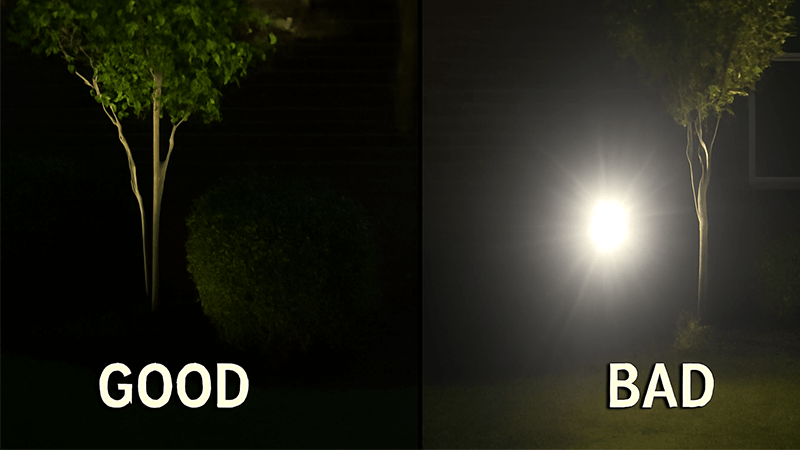
LED technology is fantastic, but like any powerful tool, it needs to be used responsibly. Poorly planned lighting can cause real problems, but thankfully, they are all avoidable with smart choices.
The Problem of Glare and Light Trespass
Glare is that uncomfortable, blinding brightness you feel when a light shines directly in your eyes. It makes it hard to see and is a common mistake in landscape lighting. Light trespass is when light spills where it’s not wanted, like into a neighbor’s bedroom window or up into the sky. Both problems come from poor fixture placement and selection. The solution is straightforward. Use fixtures with shields, hoods, or louvers. These accessories help direct the light precisely onto the target. Also, always aim your lights carefully. The goal is to light the tree or the wall, not the sky or the street.
Protecting Wildlife and the Night Sky
Bright, cool-white light can be very disruptive to the environment. It can confuse nocturnal animals, affect the navigation of migrating birds, and harm insect populations. This excessive light also contributes to skyglow, the orange haze over cities that hides the stars. To be a good steward of the environment, use light responsibly. Use only as much brightness as you need. Choose warmer color temperatures, especially those below 3000K, as they have less of the disruptive blue light. I also recommend using timers or motion sensors so lights are only on when needed.
Blue Light and Your Health
The science is clear: the blue-rich light found in many cool-white LEDs can suppress our bodies’ production of melatonin, the hormone that helps us sleep. This is why looking at a phone screen before bed is a bad idea. Constant exposure to cool outdoor lighting at night can disrupt our natural sleep-wake cycle. For residential settings, I almost always recommend warm-white light (2700K-3000K). It creates a calming, relaxed atmosphere that is much better for human well-being. Save the cooler, brighter lights for commercial and security applications where alertness is the priority.
Conclusion
Proper LED floodlights transform your landscape. Focus on the right brightness, fixture type, and placement to create a beautiful, responsible glow that enhances your property without any negative effects.